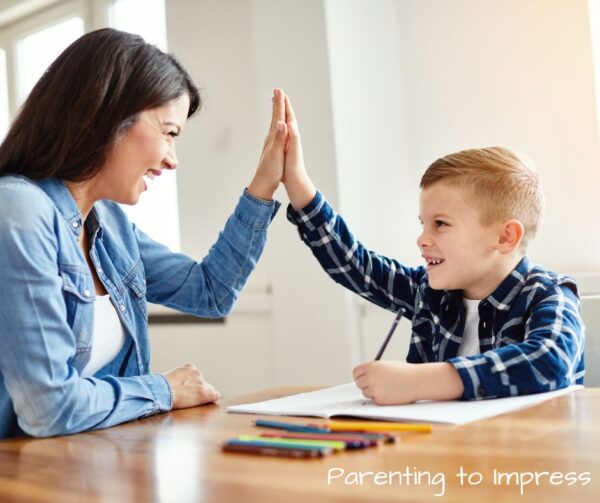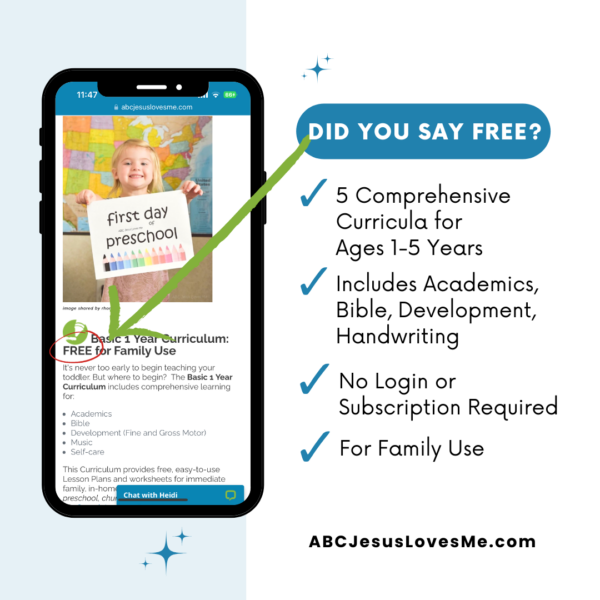If only teaching our kids looked like the picture-perfect moments we imagine—smiling child, tidy table, eager heart ready to soak in knowledge. In reality, teaching your own preschooler often feels messy, frustrating, and personal.
One mom from our ABCJesusLovesMe Facebook group put it perfectly:
“I find it is easier to teach other children, and more difficult to teach my own. My child shuts down quicker with me than others. How do you get past this?”
Friend, if you’ve ever felt this way, you’re not alone. Teaching your own child is hard because you wear so many hats—mom, nurturer, disciplinarian, provider—and then you’re adding teacher on top of it. That’s a lot. But take heart—there are practical ways to make preschool learning at home more peaceful, joyful, and effective.

Tips for Preschool Learning at Home
1. Put on the Teacher Hat.
Try to separate “Mom” from “Teacher” during school time. Come with a clean slate, leaving behind past offenses. The more you remove the personal tug-of-war, the smoother learning will go.
2. Create Realistic Expectations.
Don’t expect an energetic 3-year-old to sit still for 90 minutes. Instead, plan activities around the child’s natural attention span and energy level. Preschool learning should be play-based, with the goal of helping the child learn without even realizing it.
3. Start Small.
If your child hasn’t learned to sit for short periods, begin by teaching what “sitting” looks like—criss-cross with hands in the lap or on the knees. Make it fun with a song, rhyme, or little game so it feels playful instead of forced. Start with just 30 seconds of sitting while you read a book or teach a fingerplay, then slowly increase the time each day.
4. Watch for Clues.
If your child gets antsy or zoned out, it’s time to change things up. Try a gross motor movement break—jumping jacks, running around the house, or a wiggle song.
5. Make Learning Fun.
Preschool shouldn’t feel like “drill and kill.” Learning happens naturally in play, crafts, and everyday moments. Use the ABCJesusLovesMe Complete Curriculum or Free Basic Family Curriculum as a guide to weave lessons into your child’s play.
6. Play, Play, Play.
Shaving cream, play dough, cars, cooking, bath time, songs—almost anything can be turned into a learning opportunity. Let play lead the way.
7. Set a Routine.
Consistency helps children know what to expect. Choose a set time and place for learning so it becomes part of your daily rhythm. See sample daily schedules.
8. Protect Your Relationship.
If “school time” starts damaging your bond, pause. Sometimes, inviting another teacher or helper into the mix is the healthiest choice—and that’s okay.
9. Invite the Holy Spirit.
Begin your day in God’s Word and prayer. Ask for wisdom and strength to guide your child. Teaching isn’t just academics—it’s a spiritual calling too.

A Word of Encouragement
Mama, teaching your preschooler at home isn’t going to look perfect—and that’s okay. Some days will feel frustrating, and others will surprise you with joy. Remember, the goal isn’t to recreate a perfect classroom but to nurture a love of learning, one small step at a time. You’ve got this, and God is with you every step of the way.
What has helped you make preschool learning at home more peaceful and fun?

I’ve Done the Hard Work So You Don’t Have To!
Interested in using the ABCJesusLovesMe Curriculum in your home? Check out the Basic Free Curriculum or the Complete Curriculum. With 36 carefully designed Lesson Plans covering 9–12 months of academic, Bible, and developmental learning, these five age-appropriate curricula serve children ages 1–5. Take a peek and let me know if you have any questions!

What’s helped me most is keeping things playful, like turning chores into little games or adding music and movement breaks. It keeps my preschooler engaged and makes learning feel fun instead of forced.
Play is the key at this age!